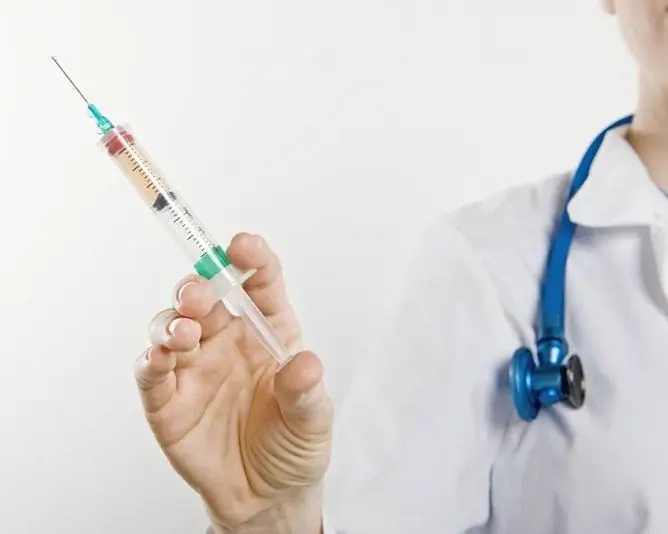- Author Rachel Wainwright [email protected].
- Public 2023-12-15 07:39.
- Last modified 2025-11-02 20:14.
Spazmaton
Spazmaton: instructions for use and reviews
- 1. Release form and composition
- 2. Pharmacological properties
- 3. Indications for use
- 4. Contraindications
- 5. Method of application and dosage
- 6. Side effects
- 7. Overdose
- 8. Special instructions
- 9. Application during pregnancy and lactation
- 10. Use in childhood
- 11. In case of impaired renal function
- 12. For violations of liver function
- 13. Use in the elderly
- 14. Drug interactions
- 15. Analogs
- 16. Terms and conditions of storage
- 17. Terms of dispensing from pharmacies
- 18. Reviews
- 19. Price in pharmacies
Latin name: Spasmaton
ATX code: A03DA02
Active ingredient: metamizole sodium (Metamizole sodium), pitofenone hydrochloride (Pitophenone hydrochloride), fenpiverinium bromide (Fenpiverinium bromide)
Manufacturer: JSC "Borisov Plant of Medical Products" (JSC "BZMP") (Republic of Belarus)
Description and photo update: 2019-09-07
Prices in pharmacies: from 123 rubles.
Buy

Spazmaton is a combined antispasmodic drug with an analgesic effect.
Release form and composition
Dosage forms of Spazmaton:
- tablets: white with a yellow tint or white, flat-cylindrical, with a chamfer and a dividing line (10 pcs. in blisters, in a cardboard box 2 or 5 packs);
- solution for injection: transparent liquid of greenish-yellow color (5 ml in ampoules, in a cardboard box of 5 or 10 ampoules).
Each pack also contains instructions for using Spazmaton.
1 tablet contains:
- active ingredients: metamizole sodium - 500 mg; pitofenone hydrochloride - 5 mg; fenpiverinium bromide - 0.1 mg;
- auxiliary components: sodium bicarbonate, lactose monohydrate, corn starch, magnesium stearate, talc.
5 ml of solution contains:
- active ingredients: metamizole sodium - 2500 mg; pitofenone hydrochloride - 10 mg; fenpiverinium bromide - 0.1 mg;
- auxiliary components: hydrochloric acid, water for injection.
Pharmacological properties
Pharmacodynamics
Spazmaton is a combined drug with analgesic and antispasmodic effects.
The pharmacological effect of Spazmaton is potentiated by the combined effect of its active components:
- metamizole sodium: being a pyrazolone derivative, it has an analgesic, anti-inflammatory and antipyretic effect;
- pitofenone hydrochloride: has a direct myotropic spasmolytic effect on smooth muscles, like papaverine;
- fenpiverinium bromide: has m-anticholinergic activity, has an additional myotropic spasmolytic effect on smooth muscles.
Pharmacokinetics
Metamizole sodium after taking the tablet inside is absorbed quickly in the gastrointestinal tract (gastrointestinal tract). It is completely hydrolyzed in the intestinal wall and in the form of an active metabolite 4-MAA (4-methylaminoantipyrine) enters the liver with the blood stream, where it is demethylated to the second active metabolite 4-AA (4-aminoantipyrine). In unchanged form, metamizole sodium is not detected in the blood.
After intramuscular (i / m) administration, metamizole sodium enters the systemic circulation quickly and almost completely. Intensive biotransformation undergoes in the liver with the formation of the main metabolite - 4-MAA, which, through further metabolism, forms other metabolites, including the pharmacologically active 4-AA. All metabolites reach their maximum plasma level after approximately 1-1.5 hours.
In total, metamizole sodium has four main metabolites, two of which, 4-MAA and 4-AA, are active, and the other two, 4-formylaminoantipyrine (4-FAA) and 4-acetylaminoantipyrine (4-AAA), are inactive. In addition, 20 additional metabolites are formed, including derivatives of glucuronic acid.
The binding of active metabolites of sodium metamizole with blood plasma proteins is 50-60%. They enter the placenta and are excreted in breast milk. The main metabolites also penetrate the cerebrospinal fluid.
The total systemic clearance of 4-MAA averages 182.9 ml / min, 4-AA - 55.2 ml / min, the half-life of active metabolites is 2.5-3 hours and 6-8 hours, respectively. In the liver, their biotransformation ends with the formation of inactive metabolites, which are excreted through the kidneys.
Pitofenone is absorbed from the gastrointestinal tract after oral administration of Spazmaton and after intramuscular administration, quickly and almost completely. The maximum concentration (Cmax) in blood plasma reaches after 0.5-1 hour. It is intensively distributed in organs and tissues, does not penetrate the BBB (blood-brain barrier).
It is metabolized in the liver through oxidation reactions. Excreted in the urine, T 1/2 (half-life) is 1.8 hours.
Fenpiverinium bromide is absorbed from the gastrointestinal tract after taking Spazmaton orally and after i / m administration quickly and almost completely. Cmax in blood plasma reaches 1 hour after oral administration. It does not penetrate the BBB. It is excreted unchanged in the urine 32.4-40.4%, in the bile - 2.3-5.3%.
Indications for use
The use of Spazmaton in the form of tablets is indicated for the relief of mild or moderate pain syndrome in spasms of smooth muscles of internal organs caused by exacerbation of gallstone or urolithiasis, biliary dyskinesia.
Solution for injection is recommended for the treatment of the following diseases:
- pain syndrome caused by spasm of smooth muscles of internal organs, with gastric and intestinal colic, spastic dyskinesia of the biliary tract, renal colic in patients with urolithiasis, dysmenorrhea - as symptomatic therapy;
- arthralgia, myalgia, neuralgia, sciatica - as a short-term treatment;
- pain syndrome after surgery or diagnostic procedures - as an adjuvant.
Contraindications
Absolute contraindications for all forms of Spazmaton release:
- decompensated renal and / or hepatic impairment;
- porphyria;
- intestinal obstruction;
- atony of the gallbladder;
- collapse;
- deficiency of glucose-6-phosphate dehydrogenase;
- period of pregnancy;
- breast-feeding;
- hypersensitivity to pyrazolone derivatives and drug components.
Spazmaton should be taken with caution in case of impaired renal and / or liver function, achalasia, gastroesophageal reflux disease, severe cardiac arrhythmias, arterial hypotension, in the period after a recent myocardial infarction.
In addition, each dosage form has additional contraindications.
Additional absolute contraindications for Spazmaton tablets:
- toxic megacolon;
- oppression of bone marrow hematopoiesis;
- tachyarrhythmias;
- unstable angina;
- angina pectoris III - IV functional class;
- decompensated chronic heart failure;
- the presence of clinical manifestations of benign prostatic hyperplasia;
- angle-closure glaucoma;
- lactase deficiency, galactosemia, glucose-galactose malabsorption syndrome;
- age up to 9 years.
Spazmaton tablets should be taken with caution (relative contraindications) for pyloric stenosis, coronary heart disease, chronic congestive heart failure, prostatic hypertrophy, chronic bronchitis, bronchospasm, patients with the aspirin triad (aspirin intolerance, nasal polyps and bronchial asthma), established non-steroidal anti-inflammatory drugs (NSAIDs).
Additional absolute contraindications for Spazmaton injection solution:
- megacolon;
- hematological diseases: leukopenia, agranulocytosis, aplastic anemia;
- prostate adenoma II - III degree;
- atony of the bladder;
- hemodynamic instability;
- acute abdomen - suspicion of surgical pathology of the abdominal and pelvic organs;
- age up to 15 years;
- individual intolerance to non-steroidal anti-inflammatory drugs (NSAIDs).
With caution (relative contraindications), it is recommended to prescribe Spazmaton injections to patients with a history of drug hypersensitivity and alcohol intolerance, with atopic pathologies (including urticaria, bronchial asthma, hay fever, nasal polyps), pyloroduodenal myucoma stenosis, intestinal atony and paralytic disease, paralytic disease,, ischemic heart disease, congestive heart failure, decreased circulating blood volume (BCC), dehydration, imbalance in water and electrolyte balance, high body temperature caused by polytrauma, unstable hemodynamics.
Spazmaton, instructions for use: method and dosage
Spazmaton tablets are taken orally.
The recommended dosage for the drug in the form of tablets, depending on the age of the patient:
- adolescents over 15 years old and adults: 1-2 tablets 2-3 times a day. The maximum daily dose is 6 pcs.;
- adolescents 12-15 years old: 1 tablet 2-3 times a day. The maximum daily dose is 3 pcs.;
- children 9-12 years old: 1/2 each. 2-3 times a day. The maximum daily dose is 2 pcs.
The duration of the course of treatment is no more than three days.
The solution for injection is intended exclusively for intramuscular administration.
A long needle should be used to inject Spazmaton.
Recommended dosage: 2-5 ml of solution 1-2 times a day. The interval between injections should be at least 6-8 hours. The maximum daily dose is 10 ml, which is equivalent to 5000 mg of metamizole sodium.
The duration of therapy is no more than 2-3 days. If necessary, treatment can be continued by taking the oral form of Spazmaton.
In the absence of a clinical response, the solution should be discontinued.
No dose adjustment is required for patients over the age of 65.
In case of impaired renal function and reduced creatinine clearance, it is recommended to reduce the Spazmaton dose.
It is necessary to avoid the use of maximum dosages for the treatment of patients with impaired liver and kidney function. Therapy without dose reduction in this category of patients can be extremely short-term.
Side effects
Possible negative side reactions from systems and organs when using all forms of Spazmaton release:
- on the part of the cardiovascular system: lowering blood pressure (blood pressure), tachycardia;
- from the lymphatic system and hematopoietic organs: leukopenia, thrombocytopenia, agranulocytosis;
- from the central nervous system: dizziness;
- on the part of the visual system: accommodation disorders;
- from the digestive system: burning sensation in the epigastric region, dry mouth;
- on the part of the urinary system: urine staining red, functional disorders of the kidneys, proteinuria, oliguria, anuria, interstitial nephritis.
In addition, each dosage form of the drug may additionally cause other side effects.
As a result of taking Spazmaton tablets, it is possible to develop allergic reactions in the form of urticaria (including damage to the mucous membranes of the nasopharynx and conjunctiva), angioedema. In rare cases, there is bronchospastic syndrome, toxic epidermal necrolysis (Lyell's syndrome), erythema multiforme (Stevens-Johnson syndrome), anaphylactic shock.
Additional side reactions from systems and organs, possible due to the use of Spazmaton injection solution:
- from the lymphatic system and hematopoietic organs: aplastic anemia, granulocytopenia, hemolytic anemia;
- on the part of the cardiovascular system: palpitations, heart rhythm disturbances, cyanosis;
- from the visual system: visual impairment;
- from the digestive system: nausea, exacerbation of stomach ulcer and gastritis, constipation; rarely - bleeding;
- from the urinary system: difficulty urinating, urinary retention;
- from the central nervous system: headache;
- on the part of the chest and mediastinal organs: bronchospasm;
- from the immune system: rash, itching, urticaria, angioedema, generalized edema, Lyell's syndrome, Stevens-Johnson syndrome, circular shock, anaphylactic shock;
- general disorders: pain at the injection site.
Overdose
Overdose of Spazmaton tablets:
- symptoms: pain in the epigastric region, nausea, vomiting, lowering blood pressure, impaired renal and liver function, confusion, drowsiness, convulsions;
- treatment: immediate gastric lavage, intake of activated charcoal and saline laxatives. For accelerated elimination of the drug, forced diuresis is prescribed, urine is alkalized by the introduction of sodium bicarbonate. Careful monitoring of the patient's condition and the use of symptomatic therapy.
Overdose of Spazmaton injection solution:
- symptoms: nausea, vomiting, drowsiness, weakness, shortness of breath, tinnitus, lowering blood pressure, tachycardia, convulsive syndrome, confusion. In addition, the development of hemorrhagic syndrome, acute agranulocytosis, renal and hepatic failure is possible;
- treatment: the use of forced diuresis, hemodialysis, with convulsive syndrome - intravenous administration of fast-acting barbiturates and diazepam. Careful monitoring of the patient's condition and the use of symptomatic therapy.
special instructions
If the use of tablets continues for more than 7 days, it is necessary to conduct a clinical analysis of peripheral blood and control of liver function.
Spazmaton's injections should be prescribed only if it is impossible for patients to take the drug inside (including in case of impaired absorption from the gastrointestinal tract). Due to the increased risk of a significant decrease in blood pressure, it is recommended to be careful when administering the drug in doses above 2 ml.
If thrombocytopenia, signs of agranulocytosis or hypersensitivity reactions appear, the drug should be discontinued immediately. To relieve hypersensitivity states, immediate administration of adrenaline, antihistamines, glucocorticosteroids is required. The characteristic symptoms of agranulocytosis include sore throat, painful sensation when swallowing, febrile condition, inflammation of the mucous membranes, including the oral cavity, nose, pharynx, anorectal and genital areas. If agranulocytosis is suspected, a complete blood count should be performed to confirm the diagnosis.
You can not take Spazmaton to relieve acute abdominal pain if its etiology has not been established.
For hematological pathologies, including a history, the administration of the solution should be made after a careful assessment of the ratio of the expected benefits and risks from therapy.
With dehydration, decreased BCC, impaired water-electrolyte balance or hemodynamics, high body temperature, the risk of hypotensive reactions increases, especially with i / m administration. In order to prevent the development of hypotension, measures should be taken to stabilize hemodynamics.
Patients with pollinosis and atopic bronchial asthma have an increased risk of allergic reactions, including the development of anaphylactic shock.
It should be borne in mind that daily and prolonged (more than three months) use of drugs with an analgesic effect can lead to headaches that cannot be relieved by high doses of analgesics.
During therapy with Spazmaton, the use of alcoholic beverages and ethanol-containing drugs is contraindicated.
Against the background of taking the drug, it is possible to stain urine in red, which has no clinical significance.
Influence on the ability to drive vehicles and complex mechanisms
Due to the existing risk of dizziness or disturbance of accommodation during the period of Spazmaton use, patients are advised to be careful when performing potentially hazardous activities that require a high speed of psychomotor reactions (including driving and working with complex mechanisms).
Application during pregnancy and lactation
It is contraindicated to take Spazmaton during gestation and during breastfeeding.
Pediatric use
It is contraindicated to use Spazmaton in the form of tablets for the treatment of children under the age of 9 years. For children over 9 years of age, therapy should be started only after consulting a doctor.
The solution is not prescribed for children and adolescents under 15 years of age.
With impaired renal function
The use of Spazmaton is contraindicated for the treatment of patients with decompensated renal failure.
With caution, only after an individual assessment of the balance of benefits and risks from therapy, the drug should be used in case of impaired renal function.
For violations of liver function
The use of Spazmaton is contraindicated for the treatment of patients with decompensated liver failure, porphyria.
The drug should be used with caution in case of impaired liver function, the appointment of Spazmaton to such patients requires an individual assessment of the ratio of benefits and risks from therapy.
Use in the elderly
For the treatment of patients over the age of 65, dose adjustment of Spazmaton is not required, provided that they do not have functional disorders of the liver and / or kidneys.
Drug interactions
With the simultaneous use of Spazmaton:
- colloidal blood substitutes, X-ray contrast agents, beta-lactam antibiotics: enhance the nephrotic effect of sodium metamizole;
- tricyclic antidepressants, allopurinol, combined oral contraceptives: one should take into account the slowdown in the metabolism of metamizole sodium while taking these drugs and an increase in the risk of its toxicity;
- NSAIDs, analgesics-antipyretics: combination with NSAIDs and analgesics-antipyretics causes an increase in the toxic effects of each of the drugs;
- H2-blockers of histamine receptors, barbiturates, codeine, anaprilin: these drugs increase the effect of Spazmaton;
- thiamazole, cytostatics: the risk of developing leukopenia increases with their combined use with Spazmaton;
- oral hypoglycemic agents, glucocorticosteroids, indirect anticoagulants, indomethacin: the components of the drug displace these agents from the connection with blood proteins, resulting in an increase in their effects;
- ethanol: the components of the drug potentiate the effects of ethanol;
- tranquilizers, psycholeptics: enhance the analgesic effect of Spazmaton;
- barbiturates, phenylbutazone, glutethimide: cause weakening of the action of sodium metamizole;
- phenothiazine derivatives, including chlorpromazine: interaction with metamizole increases the risk of severe hypothermia;
- cyclosporine: the plasma concentration of cyclosporin decreases;
- myelotoxic drugs, including chloramphenicol: metamizole sodium increases the risk of inhibition of the hematopoietic function of the bone marrow.
Analogs
Spazmaton's analogs are: Spazmalgon, Spazmogard, Spazgan, Spazmadol, Bral, Baralgetas, Baralgin, Realgin, Renalgan, Maksigan, Trinalgin, etc.
Terms and conditions of storage
Keep out of the reach of children.
Store at temperatures up to 25 ° C in a dark place, protect the tablets from moisture.
Shelf life: tablets - 3 years, injection solution - 2 years.
Terms of dispensing from pharmacies
The tablets are dispensed without a prescription, and the injection is prescription.
Reviews about Spazmaton
Reviews about Spazmaton are mostly positive. Patients, indicating the effectiveness of the drug, report its universal analgesic effect. Most often, they resort to using tablets for headache and toothache, while a rapid onset of clinical action is noted.
Price for Spazmaton in pharmacies
The price of Spazmaton for a package containing 20 tablets can range from 112 rubles.
Spazmaton: prices in online pharmacies
|
Drug name Price Pharmacy |
|
Spazmaton tablets 20 pcs. 123 r Buy |

Maria Kulkes Medical journalist About the author
Education: First Moscow State Medical University named after I. M. Sechenov, specialty "General Medicine".
Information about the drug is generalized, provided for informational purposes only and does not replace the official instructions. Self-medication is hazardous to health!






